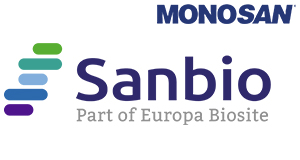Mouse anti-HLA-G Purified, clone 5A6G7 (Monoclonal)
Mouse anti-HLA-G Purified, clone 5A6G7 (Monoclonal)
SKU
SANMON23057
Packaging Unit
0,1 mg
Manufacturer
Sanbio / Monosan
Availability:
loading...
Price is loading...
Clone Number: 5A6G7
Immunogen: C-terminal amino acid sequence (22-mer) of soluble HLA-G5 and HLA-G6 proteins coupled to ovalbumin.
Concentration: 1 mg/ml
Format: Purified by protein-A affinity chromatography.
Storage buffer: Phosphate buffered saline (PBS), pH 7.4, 15 mM sodium azide
Additional info: Human leukocyte antigen G (HLA-G), belonging to MHC class I glycoproteins, plays important roles in both physiological and pathological immunotolerance. It gives an inhibitory signal to cytotoxic T cells, NK cells, monocytes, and some other immune cells. It also induces regulatory T cells and anti-inflammatory macrophages. HLA-G is important e.g. for maternal tolerance to the fetus, and for immunomodulation in particular adult tissues, such as in cornea, pancreatic islets, thymus and other. On the other hand, it is expressed in many solid and hematologic malignancies, where it contributes to evasion of the immune surveillance. HLA-G expression pattern in cancer is an important prognostic factor regarding a poor clinical outcome. Unlike most other MHC glycoproteins, HLA-G acts as an immune checkpoint molecule rather than as an antigen presenting molecule. It concerns both transmembrane and soluble HLA-G isoforms. Among other, HLA-G can promote Th2 immunological response and downregulate Th1 immunological response. For its benefits regarding allograft tolerance, including embryo implantation, soluble HLA-G (sHLA-G) can be used as a marker of developmental potential of embryos during the process of in vitro fertilization. Similarly, sHLA-G concentrations in maternal serum are decreased in preeclampsia. Transplanted patients with increased sHLA-G serum levels have improved allograft acceptance. On the other hand, increased sHLA-G can also indicate presence of malignant (sometimes also of benign) tumor cells. Another important topic is induction of HLA-G expression (sometimes associated with shedding of HLA-G from the cell surface) by some anti-cancer or anti-viral therapies, which can weaken the therapy effect. Monitoring of HLA-G in patients thus has a wide usage.SpecificityThe antibody MBH90AB recognizes the epitope EEEVE within N-terminal part of ubiquitously expressed Hsp90 alpha and Hsp90 beta intracellular proteins with calculated Mw of 84.7 kDa and 83.3 kDa, respectively, however, migrating as 90 kDa bands under reducing SDS-PAGE conditions.Application detailsFlow cytometry: Recommended dilution: 1-4 μg/ml. Intracellular staining.
Immunohistochemistry (frozen sections): Recommended dilution: 10 μg/ml; positive tissue: placenta.
Immunohistochemistry (paraffin sections): Recommended dilution: 10 μg/ml; positive tissue: placenta.
ELISA: Positive control: HeLa/HLA-G5 transfectants cell lysate, HeLa/HLA-G5 cell supernatant; negative control: HeLa cell lysate. The antibody 5A6G7 has been tested as the capture antibody in a sandwich ELISA for analysis of soluble HLA-G in combination with antibody W6/32 (cat. no. 1B-422-C100).
Western blotting: Positive control: JEG-3 cell lysate, reducing conditions, 12% AA SDS-PAGE.
Immunogen: C-terminal amino acid sequence (22-mer) of soluble HLA-G5 and HLA-G6 proteins coupled to ovalbumin.
Concentration: 1 mg/ml
Format: Purified by protein-A affinity chromatography.
Storage buffer: Phosphate buffered saline (PBS), pH 7.4, 15 mM sodium azide
Additional info: Human leukocyte antigen G (HLA-G), belonging to MHC class I glycoproteins, plays important roles in both physiological and pathological immunotolerance. It gives an inhibitory signal to cytotoxic T cells, NK cells, monocytes, and some other immune cells. It also induces regulatory T cells and anti-inflammatory macrophages. HLA-G is important e.g. for maternal tolerance to the fetus, and for immunomodulation in particular adult tissues, such as in cornea, pancreatic islets, thymus and other. On the other hand, it is expressed in many solid and hematologic malignancies, where it contributes to evasion of the immune surveillance. HLA-G expression pattern in cancer is an important prognostic factor regarding a poor clinical outcome. Unlike most other MHC glycoproteins, HLA-G acts as an immune checkpoint molecule rather than as an antigen presenting molecule. It concerns both transmembrane and soluble HLA-G isoforms. Among other, HLA-G can promote Th2 immunological response and downregulate Th1 immunological response. For its benefits regarding allograft tolerance, including embryo implantation, soluble HLA-G (sHLA-G) can be used as a marker of developmental potential of embryos during the process of in vitro fertilization. Similarly, sHLA-G concentrations in maternal serum are decreased in preeclampsia. Transplanted patients with increased sHLA-G serum levels have improved allograft acceptance. On the other hand, increased sHLA-G can also indicate presence of malignant (sometimes also of benign) tumor cells. Another important topic is induction of HLA-G expression (sometimes associated with shedding of HLA-G from the cell surface) by some anti-cancer or anti-viral therapies, which can weaken the therapy effect. Monitoring of HLA-G in patients thus has a wide usage.SpecificityThe antibody MBH90AB recognizes the epitope EEEVE within N-terminal part of ubiquitously expressed Hsp90 alpha and Hsp90 beta intracellular proteins with calculated Mw of 84.7 kDa and 83.3 kDa, respectively, however, migrating as 90 kDa bands under reducing SDS-PAGE conditions.Application detailsFlow cytometry: Recommended dilution: 1-4 μg/ml. Intracellular staining.
Immunohistochemistry (frozen sections): Recommended dilution: 10 μg/ml; positive tissue: placenta.
Immunohistochemistry (paraffin sections): Recommended dilution: 10 μg/ml; positive tissue: placenta.
ELISA: Positive control: HeLa/HLA-G5 transfectants cell lysate, HeLa/HLA-G5 cell supernatant; negative control: HeLa cell lysate. The antibody 5A6G7 has been tested as the capture antibody in a sandwich ELISA for analysis of soluble HLA-G in combination with antibody W6/32 (cat. no. 1B-422-C100).
Western blotting: Positive control: JEG-3 cell lysate, reducing conditions, 12% AA SDS-PAGE.
| SKU | SANMON23057 |
|---|---|
| Manufacturer | Sanbio / Monosan |
| Manufacturer SKU | MON23057 |
| Package Unit | 0,1 mg |
| Quantity Unit | STK |
| Reactivity | Human |
| Clonality | Monoclonal |
| Application | Immunohistochemistry (frozen), Immunohistochemistry (paraffin), Western Blotting, ELISA, Flow Cytometry, Immunocytochemistry |
| Isotype | IgG1 |
| Host | Mouse |
| Conjugate | Unconjugated |
| Product information (PDF) |
|
| MSDS (PDF) |
|

 Deutsch
Deutsch







